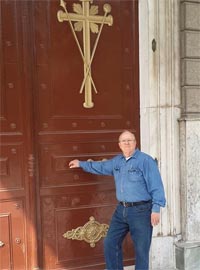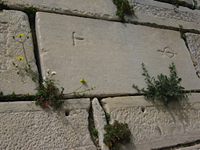June 18, 2014 By Deacon Richard Van Kirk I wanted to do something different for Lent this year and decided to take Aunt Kitty up on her longstanding invitation to visit Turkey; and besides, she is well into her eighties and recently underwent lung cancer surgery. She would benefit from the prayers and seeing family from the States. Her daughter (our cousin) Jennifer lives in the country between Izmir (Smyrna) and Ephesus with her husband Ayhan and daughter Lara. They recently bought a three bedroom multi-level home in a gated community minutes from the Aegean Sea and enthusiastically invited Linda and me to visit and explore the neighboring ancient biblical sites. My Wife Linda chose to stay home on the Ranch this time, and to “sit this one out,” providing I return with a large supply of Turkish pistachio nuts! Ayhan met me at the newly remodeled Izmir airport and took me into the city to pick up Jennifer and Lara at their elite private school. Jennifer is an English teacher; her daughter is in 8th grade. Jennifer and Lara have been commuting to Turkey’s third largest city since moving to their new home. I spent most of my time traveling with Ayhan. He helped to immerse me in Turkish culture throughout my journey and to teach me basic language. According to tradition, St. John took the Blessed Mother Mary and came to Ephesus. He wrote his Gospel in or near Ephesus and the Revelation in Patmos in 96AD. He died in the church named for him on Ayasuluk Hill. John's grave was marked by a memorial and enclosed by a smaller church in the 4th century. Two hundred years later, Emperor Justinian believed that a tomb dating from the 300s was John's, so he built the basilica on the site dedicated to the saint. The basilica erected by Emperor Justinian was one of the largest and most important churches in Christendom. Designed in the shape of a cross with a six-domed roof, it sits on Ayasuluk Hill overlooking the town of Selcuk and surrounding valley. Legends abound about the place: that it held the relics of St. John’s cloak made by the Theotokos; the original Book of Revelation was kept there; and a piece of the Cross that hung around St. John’s neck. They were lost when the Basilica was ravaged by the Ottomans in the 14th century and converted to a mosque. The building was completely destroyed in 1402 by Mongols and subsequent earthquake activity. There was a cool breeze coming up from the valley when we arrived at the Basilica. We were one of the first to arrive that morning and I was happy to have the place to myself. With everything missing and destroyed, there is no evidence to suggest the remains of the Apostle were touched. No other site claims the body of the saint. St. John must still be there, encased under what was once a magnificent altar. I made my way to the arch behind the marble floor with the simple sign noting the burial place of St. John. I sat on a brick seat in the nave behind the altar, in a place I would stand as deacon serving Mass. “In the beginning was the Word, and the Word was with God, and the Word was God.” I tried comparing the moment with the one I had at St. Peter’s tomb. “Little children, love one another. There is no greater commandment than this, that you love one another.” A Turk sat nearby and offered to give us a tour. Jennifer spoke with him and interpreted. I followed them as the man spoke to Jennifer about the various interests of the Basilica: the baptistery, an ancient prayer room, a large stone with the architect’s name on it, and another large stone with the emperor and his wife’s names engraved. I was happy not to listen. A wall of very large stones framed a marble doorway. On one of the stones, about 12 feet high, there were crude inscriptions, as if scratched with a nail or chisel, Greek symbols lying sideways. I thought it was ancient graffiti and I asked the guide who said, “Christianity will be forever.” In the ruins of a once mighty Church of God, with massive stones lying about like pebbles, in a place where Christianity was not more than a byword: Christianity will be forever.
Deacon Richard Van Kirk of St. Raphael’s Parish in Heuvelton spent time during Lent visiting family members living in Turkey. Among his stops sas in Ismir, site of St.John Cathedral. He is shown above at the entrance. This picture was taken at the Basilica of St John in Turkey. “The tau is the sign of the Cross; it has always been a symbol of Christianity. The phi has an eternal understanding. The Church will be forever,” said Deacon Van Kirk.
|
||||



